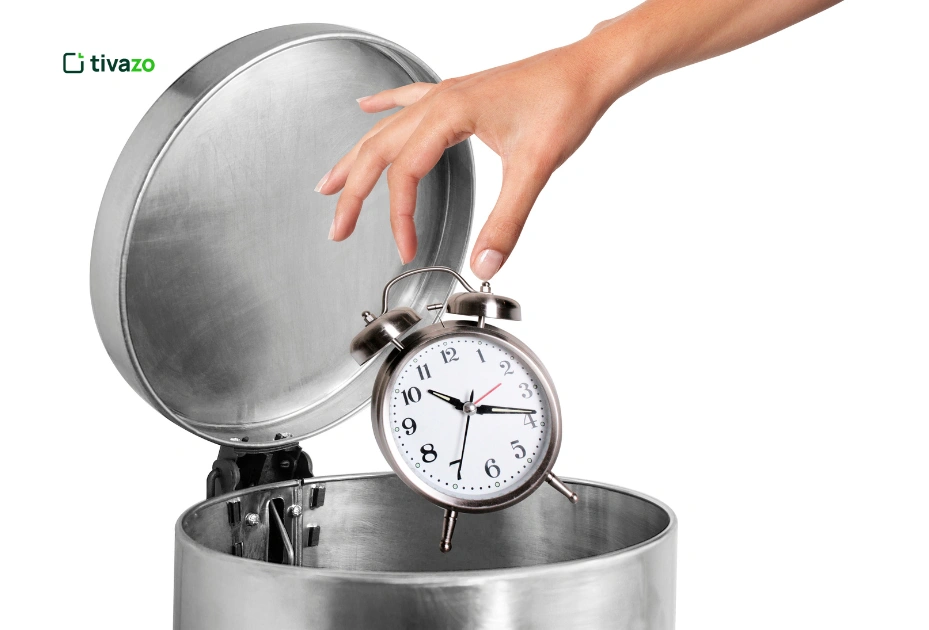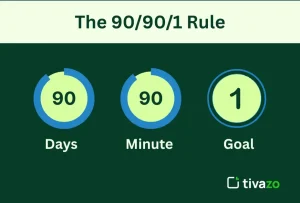In today’s workplace, productivity is essential for achieving personal as well as organizational goals. However, it is difficult to maintain your focus for long periods of time. The reality is that even in the most encouraging of workplaces, many professionals become distracted by common time wasters that eat away at a sense of productivity—routine interruptions that do not feel like they interrupt your time but can have an extremely negative impact on overall workplace productivity.
Whether it is overwhelming email demands, poorly scheduled meeting times, poorly managed tasks, or a poorly executed workflow that adds layers of difficulty; each distraction and problem aggravates your focus and deteriorates your schedule and thus your wellbeing. These distractions do not just slow down our performance; they can also escalate feelings of stress and decrease the quality of your work product.
For good time management and the most efficiency you should be aware of these pitfalls of productivity and techniques to avoid them and improve productivity. This blog describes the most common time wasters at work, with practical techniques such as a recommended approach to time blocking, the Pomodoro Technique, and other tools for staying focused, being productive, and getting things accomplished—without the feeling of burnout.
Key Takeaways:
- What Is a Time Waster? Understanding the Concept
- Why Identifying Time Wasters Is Crucial for Your Success
- Common Time Wasters at Work
- How to Avoid Them Today
- Proven Strategies and Tools to Boost Workplace Productivity
- Conclusion
- FAQs:
What Is a Time Waster? Understanding the Concept
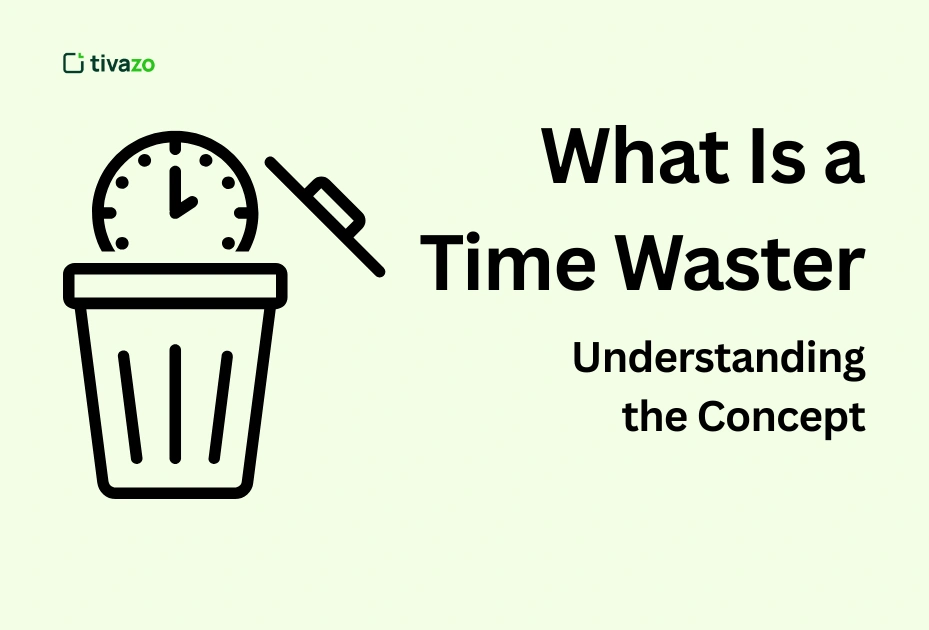
Any habit, activity, or distraction that limits your efficiency in work and contributes to a lack of productivity overall is considered a time waster. Time wasters are not always easily identifiable, and their influence can be small, such as following a constant barrage of notices, or large, such as when you sit in a meeting for an hour but really could have been e-mailed the summary. There are so many time wasters that, over time, continually chip away at your energy, instability, and progress made on other valuable work that you don’t often realize just how much they contribute to wasting time.
Everyday people often believe that merely being busy provides a means to be productive during their workday. But what is productive and what is busy are not the same; busy is simply activity and, in large part over a day, can mean many low-value tasks, double check-ins, and reactive time. In this way, instead of a productive workday, you often work longer with less to show for it altogether.
Time wasters that go unchecked often result in missed deadlines, higher levels of stress, poor judgement, and burnout. This affects not only your own productivity but can harm team implications when lack of communication and workflows are seen as normal.
Identifying these time wasters is the first and most essential step in improving your daily performance. When you recognize what’s stealing your time and disrupting your productivity, you can start making smarter decisions, reduce distractions, and stay focused on what truly matters.
Why Identifying Time Wasters Is Crucial for Your Success

Recognizing your personal-a nd team-time wasters is a critical first step for improving long-term productivity. Often, we get stuck in routines or habits that seem productive but actually are wasting valuable time ultimately adding no value. Without awareness of when these time wasters occur, it is easy to be unaware that you are simply on autopilot – wasting hours each week on activities that do not help you achieve your goals.
By becoming aware of the activities that interfere with your focus, you can then begin to make better decisions on how to utilize your time. Easier time management can take place – aiming to focus on high-impact work, more humanly planning the day, and allocating your energy to the things that really matter.
When wasted time is minimized, you also reduce the need to work on excess overtime and catching up. This enables a much healthier balance for work-life by reducing the number of times that professional responsibilities intrude on personal time. Ultimately, most will find themselves more in control and productive during their work hours while getting less overwhelmed and burned out.
Ultimately, recognizing and eliminating time wasters not only boosts day-to-day efficiency—it sets the foundation for long-term success, both in your career and personal well-being.
Common Time Wasters at Work
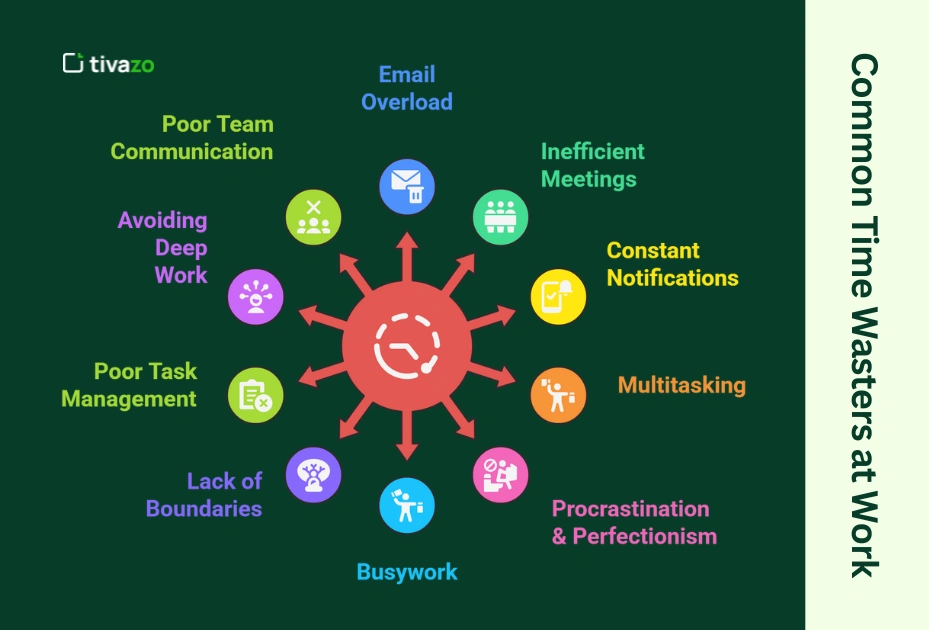
In any work environment, there are habits and distractions that slowly eat away at productivity that often go unnoticed. These time wasters such as email checking and unnecessary meetings interrupt your focus and make effective time management a challenge. By identifying these items, you can work toward increasing your workplace productivity and utilizing your workday to its full potential.
1. Email Overload: The Silent Productivity Killer
Email overload is perhaps the most underrated time-waster that occurs in today’s digital workplace. The habit of continuously checking and replying to email reduces our ability to attend to work, distracts our workflow and leads to mental fatigue. Even if you are only glancing down at your inbox for a few emails during your work sessions, it can kill your momentum and impact your overall workplace productivity.
2. Inefficient Meetings
Meetings are necessary for collaboration, but when they lack structure or a clear purpose, they become significant time-wasters. Long chats that lack an agenda, engage too many excessively, and often do not produce any actionable outcomes waste valuable work hours.
3. Constant Notifications and Chat Apps
Frequent pings from chat applications, task tools, and social media applications are a productivity poison. Every ping is a distraction to deep work, requires your brain to stop focus, change gear and then require the time to concentrate again. Both output quality and efficiency decline.
4. Multitasking
Multitasking can seem like a good use of time, but it decreases accuracy and increases fatigue. It divides your attention and makes it much harder to get high priority jobs done in an effective way.
5. Procrastination & Perfectionism
When we delay certain tasks or continually get lost in our thoughts about getting something perfect, we can often stop progress altogether. Together, these behaviours contribute to a longer work day and diminished productivity over a sustained period.
6. Busywork
We often do quiet routine tasks that do not create value—like reporting processes that are not needed, status updates that serve no purpose, or reviewing screenshots of every action an employee has taken—that just waste time without creating valuable results.
7. Lack of Boundaries
If you have no boundaries between work and home life, you probably have no personal time. Constantly making yourself available means you will burn out because you cannot focus or put enough energy into work long term.
8. Poor Task Management
With no systematic process for planning to do tasks, it is easy to lose consideration of priority and neglect deadlines or duplicate effort, particularly when you are working with a team.
9. Avoiding Deep Work
Because we shy away from deep work, our days can become fully engaged in shallow work that decides how things move forward. This gives the appearance of productivity but is not in fact productive work.
10. Poor Team Communication
Miscommunication, lack of clarity in roles and responsibilities or lack of tools for collaboration are all common reasons team time is wasted or duplicated, which is sometimes the biggest source of wasted time on a team.
These common time wasters can seriously hurt your workplace productivity and disrupt your focus. Identifying them is the first step to better time management and a more efficient, balanced workday. By tackling these distractions, you’ll boost your productivity and create a healthier work environment.
How to Avoid Common Time Waster at Work
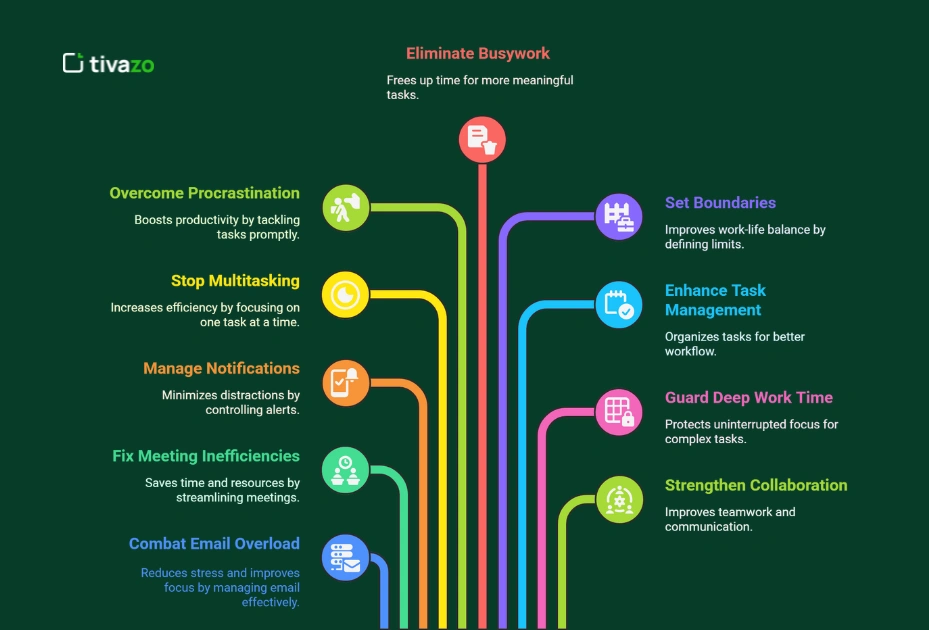
Selecting the right strategies and frame of mind ultimately builds a foundation for managing time and reducing distractions. Here are documented strategies you can take to eliminate time wasting bad habits, enhance concentration, and improve productivity in the workplace.
1. Combat Email Overload
Check emails only at specific times throughout the day, so that you do not have constant interruptions. Create folders and utilize filters to prioritize and organize messages. Additionally, schedule uninterrupted time when you will not check email.
2. Fix Meeting Inefficiencies
Only schedule a meeting if it is the only possible solution, and only if you will use a specific agenda. Maximize the use of async tools when progress or updates are required. Distinguish between types of updates, and maintain strict time limits to enforce better productive meetings.
3. Manage Notifications and Chat
Put your phone to “Do Not Disturb,” (just for example) so you are not interrupted during your focus hours. Schedule specific moments for checking messages. Utilizing the features available within an app can lower distractions as often.
4. Stop Multitasking
Prioritize tasks using tools like the Eisenhower Matrix to guide the focus of tasks. Focus on completing one task at time, and batch similar tasks for efficient productivity.
5. Overcome Procrastination and Perfectionism
Use Pomodoro intervals (concentration intervals with breaks) for focused work. Schedule small deadlines into your day/week for projects, and settle for “good enough” to avoid delays.
6. Eliminate Busywork
Identify busywork, or less valuable tasks, that you can delegate or automate to free up time for more important work.
7. Set Boundaries for Work-Life Balance
Set “working hours” and refuse to check work notifications after hours. Share your availability to promote healthy teamwork and special daily accomplishments.
8. Enhance Task Management
Use systems like Trello, Asana, or Tivazo to manage work tasks. Use time blocking and prioritize daily tasks to manage your day effectively.
9. Guard Deep Work Time
Have time blocks that are uninterrupted for deep work. Ensure you are working in a quiet area and let your colleagues know you are deep in focus time for interruptions.
10. Strengthen Team Collaboration
Use async collaboration tools, ensure role clarity, and stay aligned (15 minute daily sync instead of long drawn out time suck syncs) to not duplicate work tasks and efforts to avoid emotional burnout from your workday.
Take these tips and you will be on your way to minimizing time wasting incidents, having more focused time, and higher productivity while on the job.
Proven Strategies and Tools to Boost Workplace Productivity
Addressing time-wasting goes beyond being aware; it requires practical techniques and the right tools. Time blocking is a technique for time management that organizes your day into blocks of time that are dedicated to the completion of a specific task or group of tasks. This technique will reduce the likelihood of being distracted and procrastinating.
There are easy to use digital tools that can track projects and assignments for a team, like Jira and Trello, that many teams use. There are automation tools that perform testing or assigning tasks that free up your time for more productive tasks.
For organizations looking to provide a full evaluation including tracking organizational tasks with employee performance tasks, there are platforms like Tivazo. Tivazo contains valuable tools that improve workflow steps, ensure you are reaching your goals, and keeping employees engaged.
On top of the time blocking and digital tools, you might also want to use a focus app that reduces or removes notifications to take full advantage of the correct environmental conditions to help you be as efficient as possible.
Conclusion
Time wasters are stealthy productivity assassins that will sap your effectiveness and job satisfaction. When you add up daily distractions like too much email, too many unproductive meetings, procrastination, or poor task management, they really add up and consume your time and energy.
Once you know your time-wasters and employ proven tactics like the “Pomodoro” approach, time blocking technique, or productivity management tools like Tivazo, Jira, or Trello, you can prepare your workday for success. You will increase your success by setting clear boundaries, establishing better collaboration practices, and allowing priorities of deep work.
Make today the day you know where you are wasting time and start eliminating some of the waste. You will be glad you did and your productivity and career will appreciate it.
FAQs:
What is a time-waster?
A time-waster can be defined as any activity, behavior, or distraction that impacts your ability to effectively work or accomplish goals. Time-waster in the workplace could include anything from unnecessary meetings, checking email too often, multitasking or poor planning, all of which will take your focus away and drop productivity.
What are your top 3 time wasters?
The top 3 most common time-wasters at work:
- Email Overload – Checking your email at all times of the day
- Ineffective meetings – Meetings without a purpose
- Multitasking – Switching between all types of work and being less efficent
Each one of these is detrimental because they break concentration and interefere with your productivity.
How can you avoid time wasters?
Avoiding time wasters starts with awareness and good time management practices. Set clear priorities, use task planning tools like Tivazo or Trello, and block distractions by scheduling dedicated work sessions. Automation, delegation, and better communication also reduce wasted time.
How can I avoid wasting time?
To avoid wasting time:
Start each day with a task list and clear goals.
Use techniques like time blocking and the Pomodoro Technique.
Eliminate or delegate low-priority tasks.
Minimize interruptions by muting notifications during focus blocks.
These steps can significantly improve your daily productivity.
How can you manage time and explain time wasters?
Time management means planning how to divide your time between tasks effectively. By identifying your biggest time wasters—such as procrastination, lack of boundaries, or poor communication—you can make adjustments like setting routines, using tools, or prioritizing tasks to work smarter.
How can you minimize distractions at work?
Minimize distractions by:
Using “Do Not Disturb” modes during important work.
Scheduling set times to check messages or emails.
Creating a clutter-free workspace.
Using focus apps or browser blockers.
These steps help preserve mental energy and boost workplace productivity.
Which strategy helps minimize distractions?
One of the most effective strategies is time blocking—reserving dedicated time slots for specific tasks. Pair this with the Pomodoro Technique, where you work in focused intervals, and use apps like Tivazo to keep your workflow organized and distraction-free.
What are three ways to minimize distractions?
Here are three proven ways:
Silence notifications during deep work sessions.
Create a focused workspace with minimal clutter.
Plan your day using task management tools to reduce uncertainty and keep attention on what matters.
